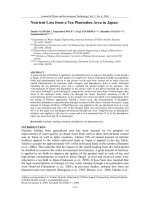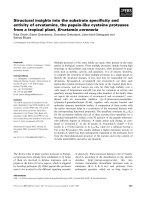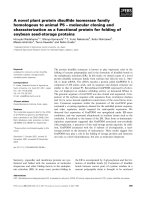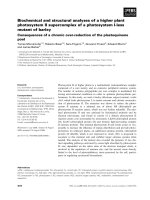Developing a Marketing Plan
Bạn đang xem bản rút gọn của tài liệu. Xem và tải ngay bản đầy đủ của tài liệu tại đây (69.9 KB, 4 trang )
Developing a Marketing Plan
Marketing plans may be long or short, and they will vary among organisations/regions.
Whatever their length of character, they are valued as a tool for effective planning and
assessment of productivity. The following are some general guidelines for developing a
marketing plan. Your Marketing Plan can be more comprehensive than the example but it
should include at least the following chapters.
1. Executive Summary
Summary is one of the most important parts of the marketing plan. The objective is to give
clear understanding what this marketing plan is about without getting into details. Although
the summary is located under the first chapter, it is usually completed last after the whole
plan is complete.
The lengths of a summary should be approximately 2-3 pages.
2. Situation Analysis
First, an organisation needs to assess its present situation. This assessment will explore the
realities of the industry, the community, the travel product, the economic environment and
the potential or present visitors. For tourism marketing, some of the following questions
should be asked, the answers to which will give an organisation a better understanding of its
current situation.
a) What is the present demand for tourism activities and attractions in your
community?
b) What facilities and resources do you have to market to visitors?
c) What is your community known for? What kind of image does the destinations have
to outsiders? And to people who live there?
d) What are your strengths and weaknesses as a community and how do they impact
your tourism markets?
e) What changes do you anticipate in the next five years, and will they impact your
ability to attract visitors to your destination?
f) What other trends might impact your community/destination?
g) How responsive is your community to having visitors?
Developing a situation analysis is fundamental to better understand the capabilities,
potential and interest that may exist for visitors within a destination.
3. Objectives and Goals
The second element in developing a marketing plan is the establishment of measurable
goals. This can be accomplished only after carefully considering the demand and supply
potential of the visitors to a destination. Questions that address this issue are as follows:
a) What kind of goals should be established? Should they be short and/or long term? Is
there a baseline against which such goals are being set?
b) What kinds of tourism markets should be targeted and what are the goals for each
market segment?
c) How will the organisation assess the attainment of these goals?
d) Are the goals realistic in terms of the organisation’s resources, timelines and travel
products?
4. Market Segments
1
The third essential element in a marketing plan is that of identifying and selecting the target
markets. This is usually called market segmentation. No bureau is equipped with financial
resources to simply “market”, “sell”, “advertise” or “promote”. In fact the competition has
become so sophisticated that bureaus must identify a dn carefully define their target
markets. For tourism sales and marketing efforts, some of those markets may be defined as
follows:
a) Vacationing Families / Pleasure Travellers
b) Incentive Travel/Business Travellers
c) Domestic Group Tour Planners
d) International Wholesalers
e) Travel Agents
f) Travel Writers-Media
There are additional means for dividing market segments. For example, when examining the
general “pleasure traveller” market segment, a organisation, depending on its location and
possible seasons, may wish to target its efforts to specific, identifiable subgroups. Each
market segment potentially requires a different set of strategies and may require different
vehicles for communicating a message. It is fundamental that an organisation knows and
understands the characteristics of various market segments. There are several ways of
examining market segments through demographics, psychographics and geographic
analysis.
Demographic variables most commonly used to identify groups include age, sex, income,
expenditure patterns, occupation, education, household size, marital status and ethnic
background.
Psychographics pertains to an individual’s underlying motivations for travel. We can talk
about hunters and skiers, which is a means of defining market segments on the basis of
behaviours. Psychographic research (or personality research) goes beyond demographics
and asks why people behave or select travel products in a certain way. It wants to get at the
root of their decision making process, it wants to find out why some select one destination
over another or one mode of transportation over another and why different people travel.
Psychographic research can measure which population segments will travel, what motives
can be identified to increase their potential to travel, what kinds of destinations are
preferred, what activities they wish to engage in upon arrival, and what kind of marketing
themes need to be creatively developed to focus on their motives and needs.
Geography is another means of defining a market segment; for example, an organisation
may find that it has a potential market for daytime or overnight tours from group operators
within a five-hour drive of that destination. Specific events or activities, such as antique
fairs, cultural events or special pageants may be interest to those tour operators who have
groups that wish to spend only a day away from their homes. Geographically, this opens a
new market segment for an organisation.
5. Marketing Strategies
The fourth element in a marketing plan is that of identifying and selecting the appropriate
and most productive marketing strategies for the targeted market. There are an abundance of
techniques available to an organisation; asking some of these questions will provide
guidelines for selecting the best techniques for each market segment.
a) Which selected marketing strategies will be the most effective for an identified
market segment? What are the strengths and weaknesses of a strategy? Who are
affected by a selected strategy?
2
b) What combination of strategies might be most productive in reaching a selected
market segment?
6. Resources
Fifth, an organisation needs to allocate its resources adequately to support the programs
outlined for attaining the desired goals. Without funding and personnel, programs will
simply not be productive.
a) To what extent will personnel and money be dedicated for a specific program?
b) Will the allocation be sufficient to reach the desired program goal?
c) Does the organisation have other community resources that might be employed
towards a specific program to ensure its success?
The issue of funds and staff time becomes a critical element in planning, particularly for
smaller organisations. But with planning and some creativity, programs can be implemented
and a level of success attained. This chapter should include also an clear and transparent
marketing budget.
7. Implementation
Sixth, a marketing plan needs to be implemented. When do you do the things you have
outlined in a plan? Timing has a lot to do with how successful a marketing plan will be. It
affects the placement of advertising and its impact on the targeted market segment; it also
will affect how successful one might be in reaching planners during or prior to their
planning time. Questions that might direct the implementation of a plan include:
a) When is the best time to launch a specific marketing strategy for a specific market
segment?
b) What kinds of lead times applicable to various market segments would impact goal
attainment?
c) In what sequence should various marketing elements be implemented? Does one
strategy need to follow another to maximize impact?
d) And far from least, who is doing what, when, how and with whom? In implementing
a program, is it coordinated for maximum bureau efficiency?
Organisations always face pressures to implement programs that will provide immediate
return on investment. This may not always be the case, especially in the travel trade.
8. Assessment
Last, an organisation has to be able to assess the effectiveness of its marketing programs.
This does not always mean change; in fact, if a program continues to prove of value, then
there may be little reason to change it. On the other hand, if a marketing effort seems to
fizzle, being able to make an evaluation then is imperative.
a) What kinds of results are being sought in a specific marketing effort? Are the results
quantified?
b) What kinds of criteria have been established against which to assess a marketing
program?
c) What kinds of contingencies have been developed for a program that may prove less
effective that intended?
Because of the diversity of market segments, which compose the tourism industry, a marketing
plan is much like a navigational chart. The marketing plan requires a look at all the relevant
3
activities, define goals, identifies markets, selects strategies, makes assessments and determines
results. Navigation likewise plots courses, charts status and aims for the final destination. The
development of a marketing plan does not require intensive scholarly work; it is an attitude that
will govern and influence the directions an organisation intends to go. The investment of time is
critical to the most efficient use of organisation’s resources.
These guidelines are based on “Destination Marketing” by Richard B. Gartrell.
4









